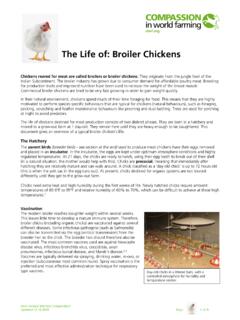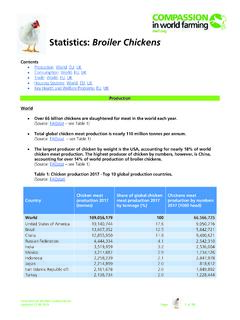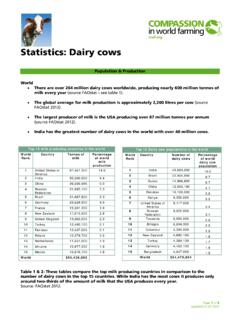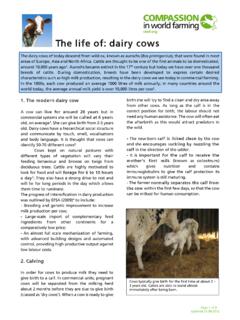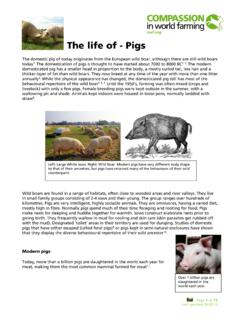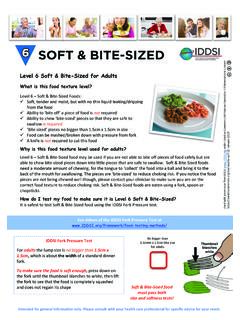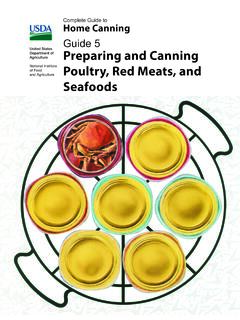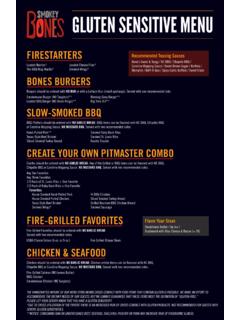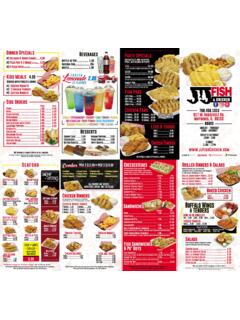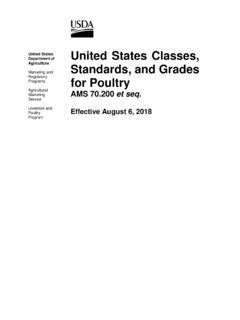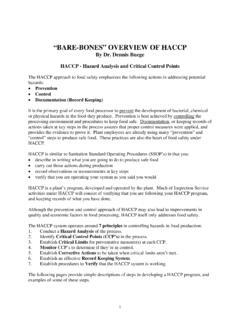Transcription of Welfare Sheet: Broiler chickens - Compassion in World Farming
1 Welfare Sheet: Broiler chickens Welfare issues associated with intensive rearing systems .. 2. Genetic selection for fast growth .. 2. Welfare issues specific to high stocking densities: .. 3. Welfare issues specific to environmental conditions ( air quality, ventilation, ventilation, temperature, litter quality): .. 4. Higher Welfare systems for Broiler chickens .. 5. Alternative systems .. 5. Broiler .. 7. Welfare issues across all Broiler systems .. 7. Catching and crating (manual or automatic).. 7. Welfare issues associated with transport .. 8. Welfare issues associated with slaughter.
2 9. Broiler parent birds ( Broiler breeders') .. 10. Nutritional value of higher Welfare chicken meat .. 11. chickens specially bred for meat production are called Broiler chickens ' or broilers'. Typically, broilers are young chickens which have white feathers and yellowish skin. Since the 1940s, strong trong consumer demand for affordable, safe and healthy poultry meat has stimulated the growth of the Broiler industry. industry Genetic selection and improved nutrition have been used to increase the weight of breast- muscle (leading to broader breasts) and faster growth rates.
3 However this has had implications for the quality of life, health and walking ability of Broiler chickens1. Globally, over 70% of broilers are raised in industrial Farming systems2 and slaughtered at an age of around 5 7 weeks depending on the country they are reared in. In the UK, the rest of the EU, USA, Brazil and China the majority of chicken meat originates from intensive systems. This type of production is rapidly being replicated in developing countries3. This document gives an overview of the different Welfare problems that are associated with intensive meat chicken production.
4 It will also outline how these Welfare problems may be overcome in housing systems that offer an alternative to intensive production. There are serious Welfare issues associated as with the breeding and intensive rearing of broilers and it is generally accepted that most of the Welfare problems are caused by genetic factors, environmental factors and A typical Broiler chicken is a young the interactions between them4. bird (with a less developed comb and wattles) that only lives for about 5 7 weeks before slaughter depending on the country it is reared in.
5 Farm Animal Welfare Compendium Updated Page 1 of 17. Welfare issues associated with intensive rearing systems Genetic selection for fast growth Broiler chickens are among the fastest growing farmed species. Intensive genetic selection has led to birds that have a typical average daily weight gain of about 50 g. g However, some breeds grow as much as 90g/day5 and at over 35 days more than 100g/day. Thehe intensity of genetic selection over the last 80 years or so, the age of slaughter has been decreasing 1 day a year, year and market weight increasing. Figure 1.
6 Market age and weight changes since 1925 of commercial commercial Broiler chicken production in the US (slaughter birds at around 7 weeks) 6. Welfare issues specific to fast growth rates: rates Higher Mortality: The average mortality (including spontaneous deaths and the culling of diseased birds by stock people) was in one large study7 (18% was not unusual in thee 1920s8). Changes in breeds, growing period, management and disease control have improved levels but rapid growth rates still result in many mortalities. The larger EU Broiler companies (that slaughter at an age of 32 to 40 days), days) work to reduce overall mortality to less than 5% in the production period9.
7 Increased risk of lameness: Skeletal disorders such as bone deformity formity and other leg disorders can lead to impaired walking abilities and lameness. lameness Lameness problems are multi-factoral factoral but studies have shown that fast-growing growing chickens have higher rates of lameness compared to slower-growing slower growing breeds. Birds with severe walking problems are experiencing pain10. Rapid growth of broilers results in a quick increase in body weight, which puts their skeletal keletal system under stress. When this happens, fast growing chickens become less active and have more leg disorders.
8 Disorders However, the legs of slower growing broilers are better able to carry their body weight, and this does not lead to bone and joint problems11. A large study found that on average verage 57% of the fast growing birds had severe walking problems, problems whereas flocks with alternative, slower growing strains only about 17% had severe walking problems12. In 2008, a survey of 176 UK Broiler flocks (representing million broilers) found that had severe walking problems and were almost unable to walk; overall of the birds had some degree of gait abnormality13.
9 Breeding programs have helped improve improv overall bone quality and leg health but some advantageous genetic changes are leading to new bone problems, such as black bone syndrome, syndrome make bones Broilers with leg problems are common in intensive systems. Leg weakness leads to more porous, so more likely to break14. lame and lethargic birds that are not able to move. Farm Animal Welfare Compendium Updated Page 2 of 17. Contact dermatitis: Inflammation of the skin on the breast, hocks and feet (also called footpad dermatitis or FPD) is a widespread problem in Broiler production and is often more severe in fast growing birds.
10 Its caused by prolonged contact between the bird's skin and wet and dirty litter, but several other factors such as health, diet, and (indoor) climate also play a role (see below)15. In severe cases the lesions can develop into inflamed ulcers which cause pain. Overtime the birds' droppings mix with the litter on the floor. Wet litter can lead to soiled birds which can develop into FPD. A study in EU slaughter houses found that: - Prevalence of hock burns was about 20% in standard, fast growing broilers and less than 1% in slower growing broilers from alternative housing systems.
